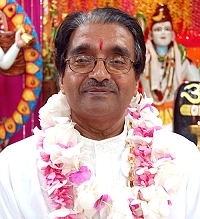Paramacharya of SWAHA, Pundit Hardeo Persad
In Hinduism, numbers have a significant and meaningful role in our rituals and prayers. The number 108, for example, is a very auspicious number with many dimensions. The planets have great relevance to Hinduism. If we examine the external world, it is instructive to note that there is a numerical correlation between the earth and the other planets. The earth is about 93 million miles from the sun. The diameter of the sun is said to be 864,000 miles. If you divide the distance of the earth from the sun by 864,000, the result is 108. With respect to the moon, if you look at the diameter of the moon (3,476 km) and divide it by its distance from earth, about ¼ million miles, the result is 108. There’s a cosmic correlation between the planets, and 108 appears to be a significant number.
The Vedas declare, Yatha Pinde, Tatha Brahmande, ‘As in the microcosm, so in the macrocosm.’ In other words, the outer world is reflected in the internal world. In the microcosm of the individual, there are seven major energy vortices (chakras) and two minor ones. There are also 72,000 channels of bioenergy (nadi) crisscrossing through the body, which are connected to the chakras. When we chant our mantras 108 times, the result is the activation of the energy vortices and so that we can raise ourselves energetically and spiritually.
If we look at the digits themselves, 1 – 0 – 8, the number one implies unity. It is a factor of all numbers. Carl Sagan, an astronomer, tried to analyse prime numbers in order to understand them from a point of view of creation. A prime number has two factors only, itself and one.
The concept of zero is extremely important in mathematics. The zero placed in the middle of 108 gives the one and the eight their value mathematically. In Shiv Maha Puraan, there is the concept of destruction and reabsorption. Destruction signals a change in the order of things, but matter still exists. With reabsorption, absolutely nothing exists. There is no earth, no element, no form. It is beyond time and activity. Nothingness is a very difficult concept for the human mind to grasp as we are born into a world of forms, objects and time. The symbol zero represents that state of nothingness, the indefinable and infinite unmanifest, which is the substratum of all existence.
For the number one to exist, there must be creation as it implies a point in space. That infinite manifests itself in the form of Param Shiva. The Shiv Maha Puraan states that the universe consists of eight forms of Lord Shiva. These are eight presiding deities:
- Bhava is the form of water;
- Sharva is the form of earth;
- Rudra is the form of the fire element;
- Ugra relates to the wind;
- Bheem relates to the ether element;
- Pashupati is the individual soul;
- Ishaana is the sun;
- Mahadeo is the moon.
Eight represents the entire creation. We are microcosmic representations of the universe; it relates directly to us as human beings.
From a numerological perspective, the numbers 1-0-8 add up to nine. In Hinduism, nine is associated with Durga Devi (Nav Durga and Navraatri). Mathematically, nine is a perfect square number. Nine also relates to the world of form and objects. Everything in the world is energy vibrating at various frequencies, including the human body itself. Devi is the personification of energy. In this world there are also nine factors to which we are all subjected:
- Space, time, and causation (karma);
- The three modes of existence (gunas): sattva (peaceful, pious), rajas (materialistic, active), tamas (inert, sluggish);
- Creation, sustenance and dissolution.
Other significant numbers include the number three: in puja, water is passed around the fire three times (aachman), which symbolises purification. Also, bhu, bhuvah and swah are the three planes of existence. Devotees bow to the fire five times, because each act purifies an element (tattwa) in the body.
When devotees plant the jhandi (sacred flag) at the end of a puja, and place 11 teekas on it, it symbolises the purification of the 11 life principles. It represents going within ourselves and identifying with Shivaji, the state of dispassion.
Lakshmi Mata is associated with the number six. There are six forms of spiritual wealth: tranquillity of mind, serenity, control of senses, endurance, faith and renunciation of selfish desires and actions. In placing six teekas on the jhandi, the devotee is conveying the intent to acquire these six forms of spiritual wealth.
Saraswati Mata is associated with the number seven, which is the number of creation. In biology, we are told that all living things carry out seven functions: growth, reproduction, irritability, movement, nutrition, excretion and respiration. Saraswati Maa is the creative energy and the source of knowledge.
Hanumanji is associated with the number five. Panchmukhi Hanuman is depicted with five faces. Hanuman represents the mind principle and there are five mental states: the raving mind, the forgetful mind, the oscillating mind, the one-pointed mind and the restrained mind. Worship of Hanumanji helps us rise beyond the lower planes of the mind and attain the highest state.
In Hinduism, all aspects of divinity are associated with a number, colour, form and yantra (a mystical diagram). It is important that we follow the path of gyaan bhakti, enlightened ritualism, in order to truly understand the depth and significance of our rituals and prayers.
(From an interview on 90.5FM)



